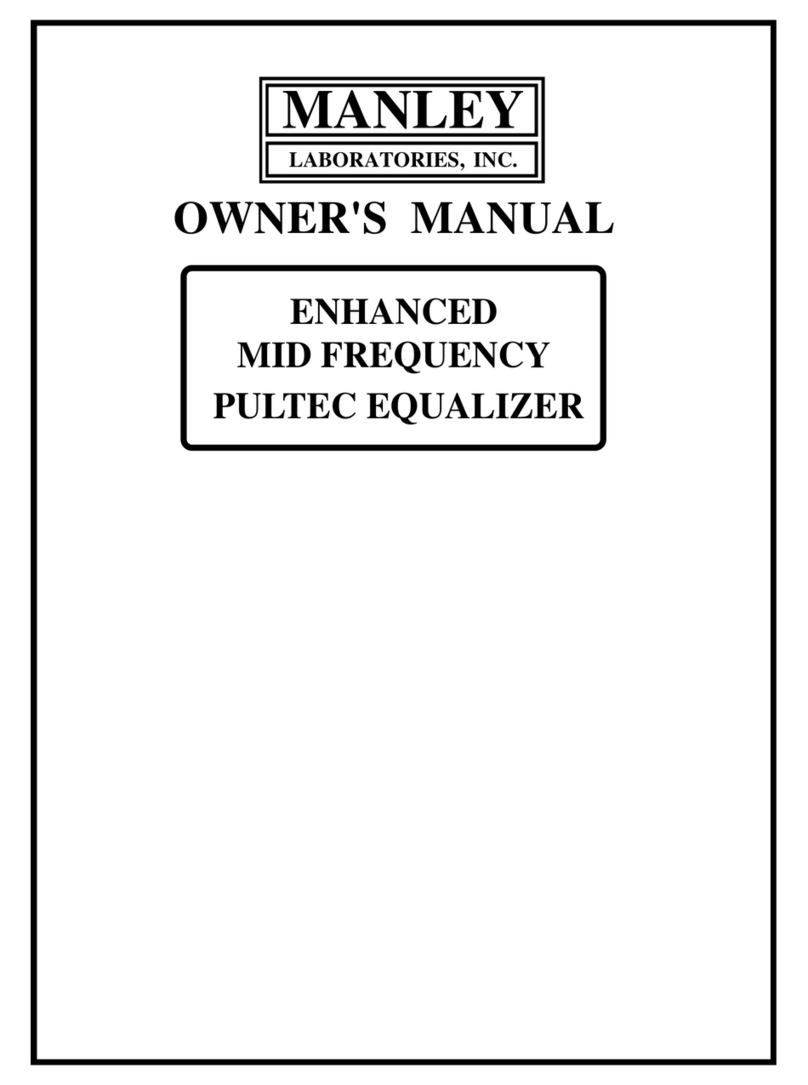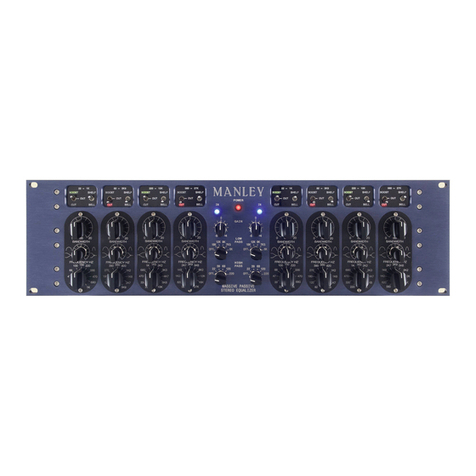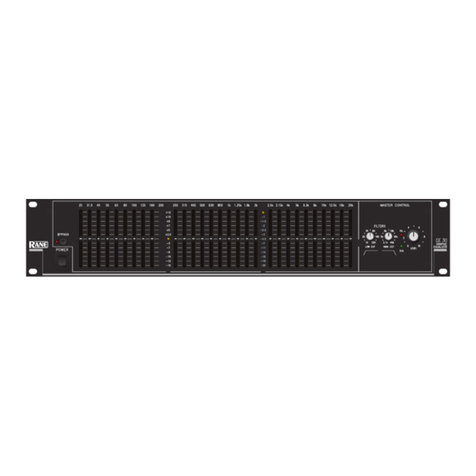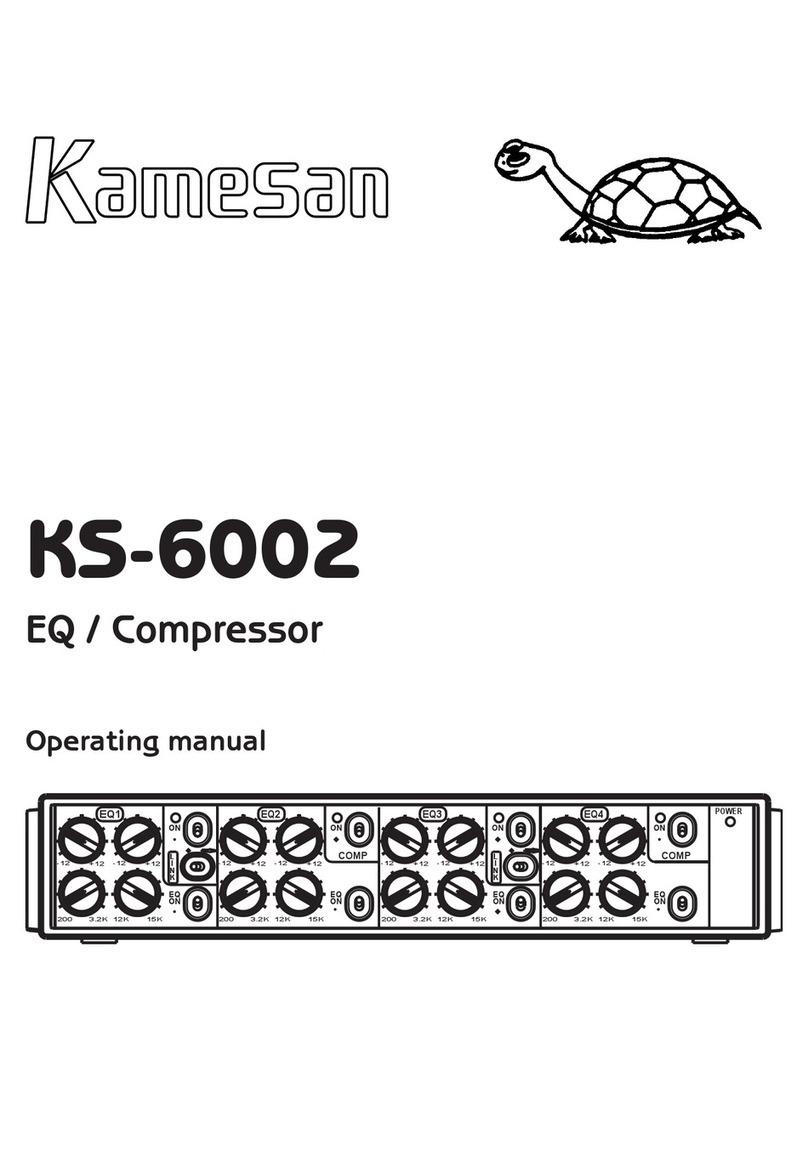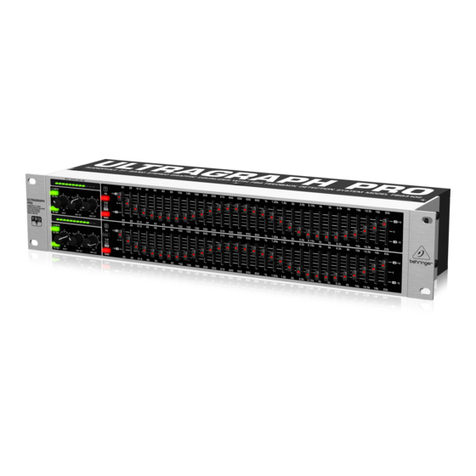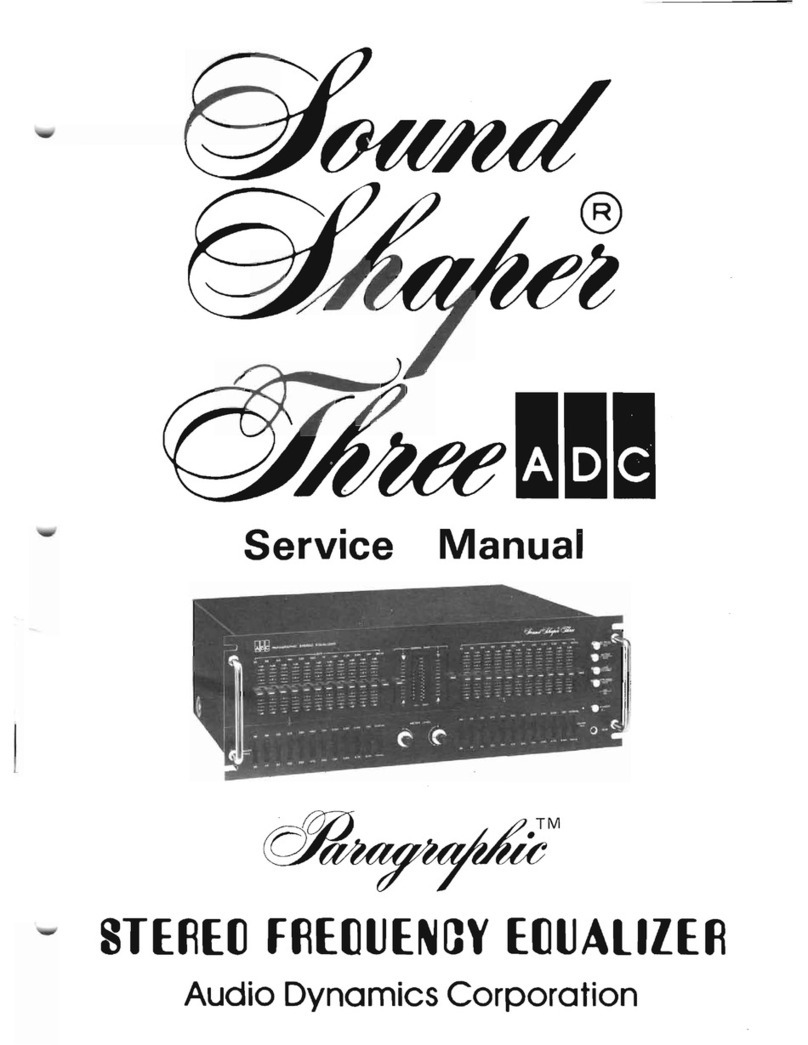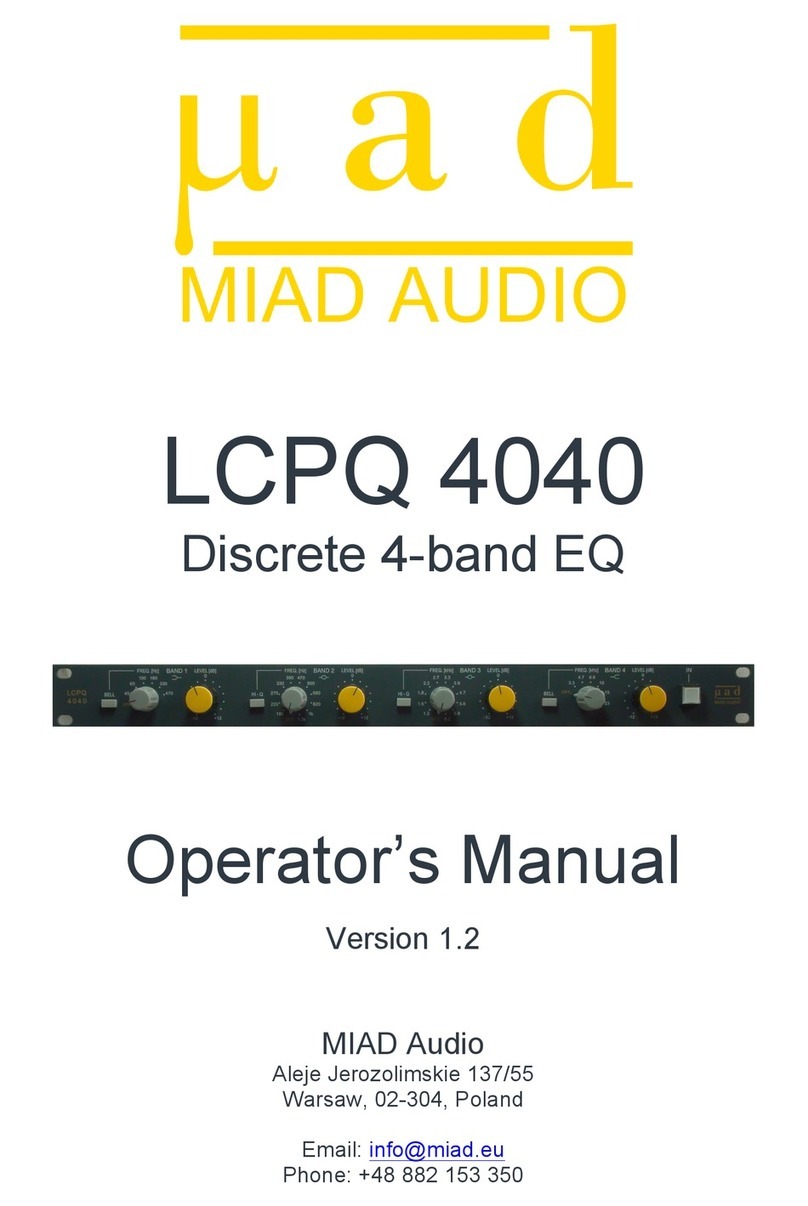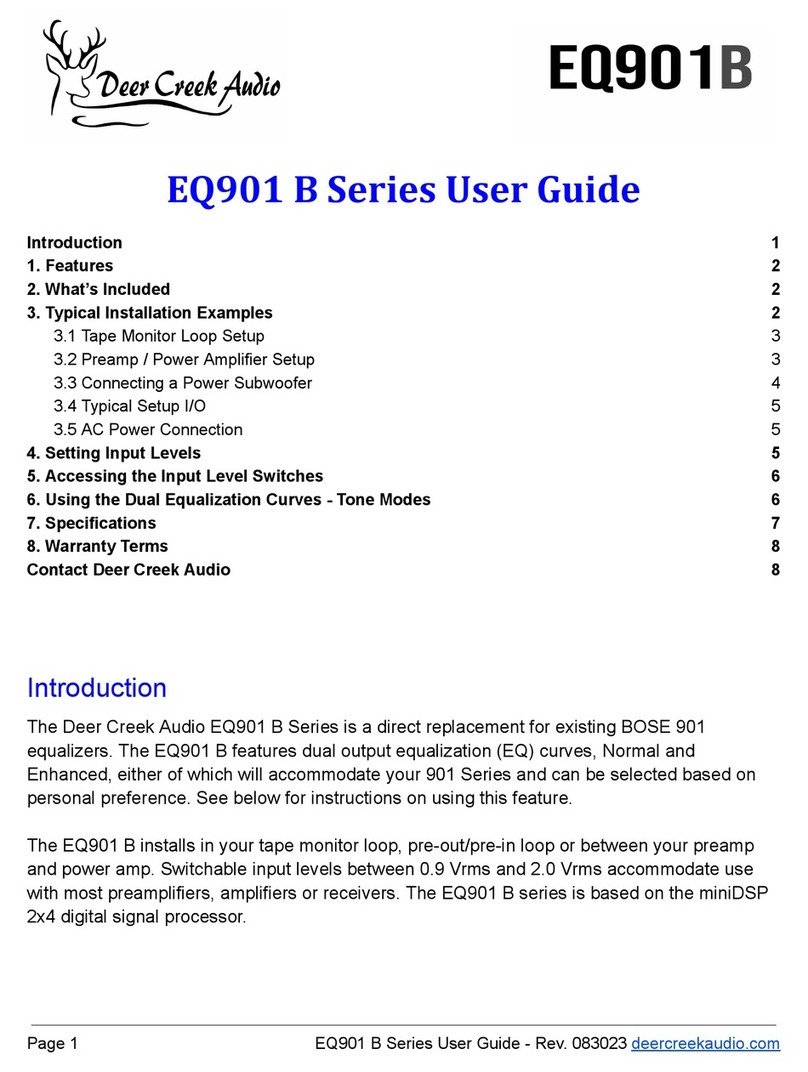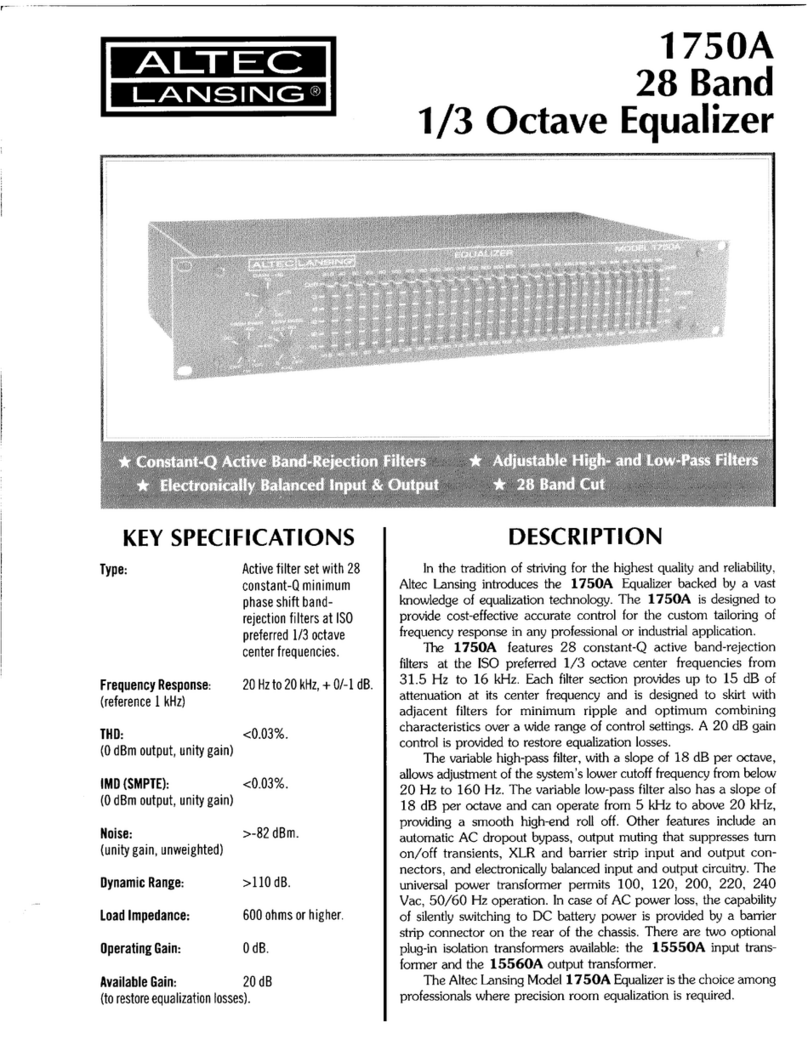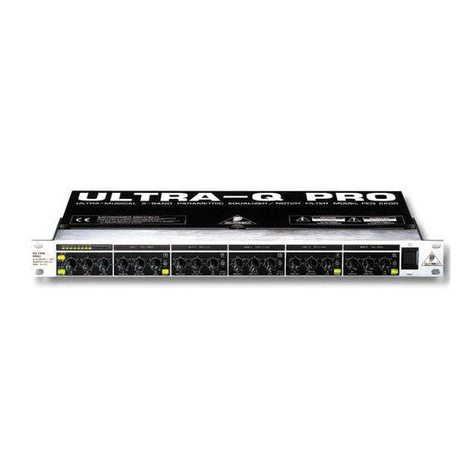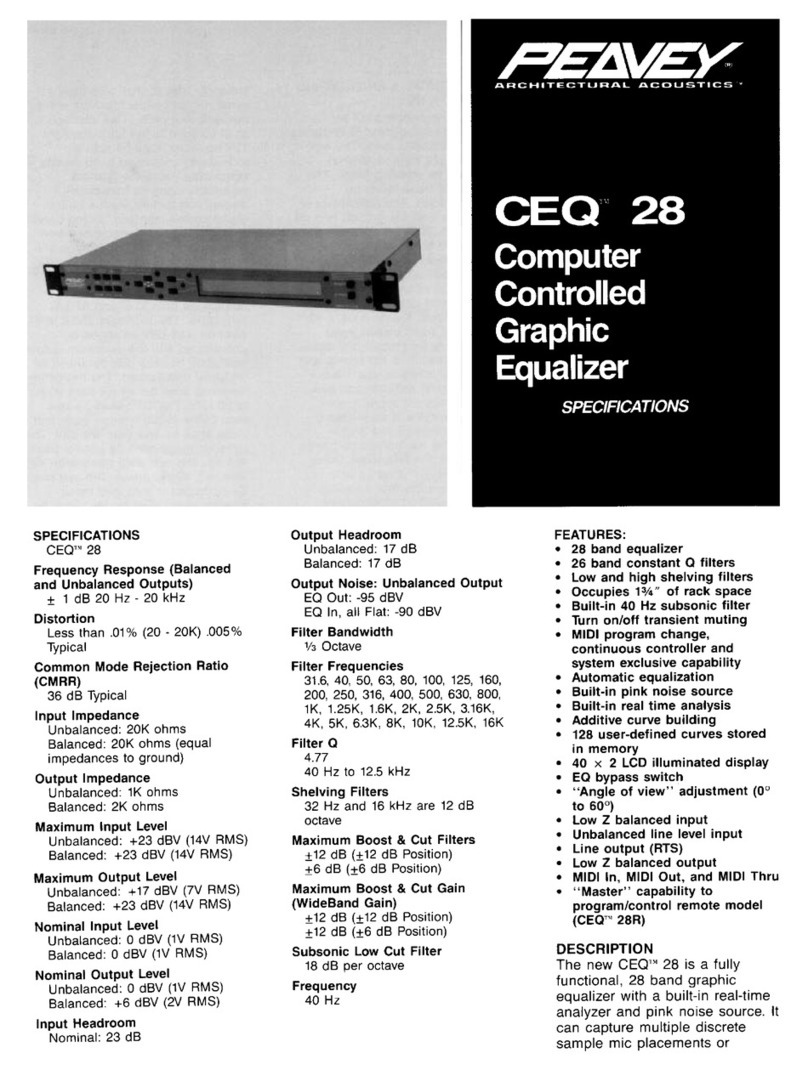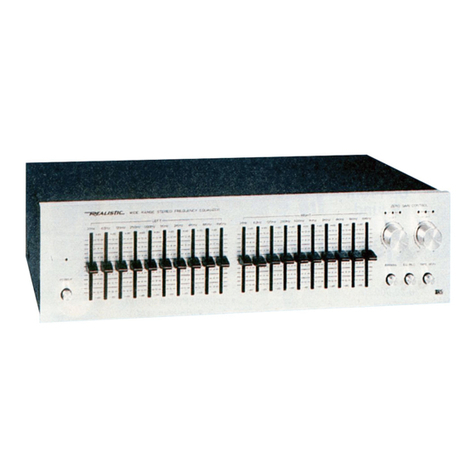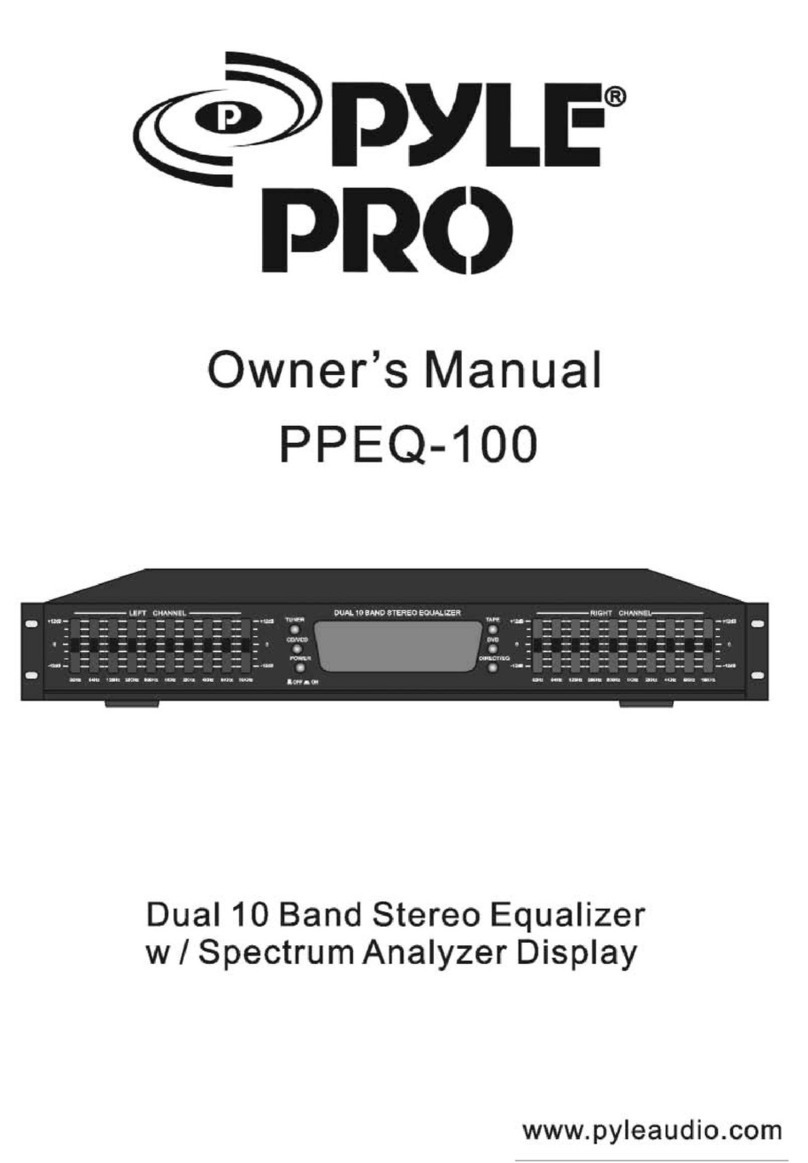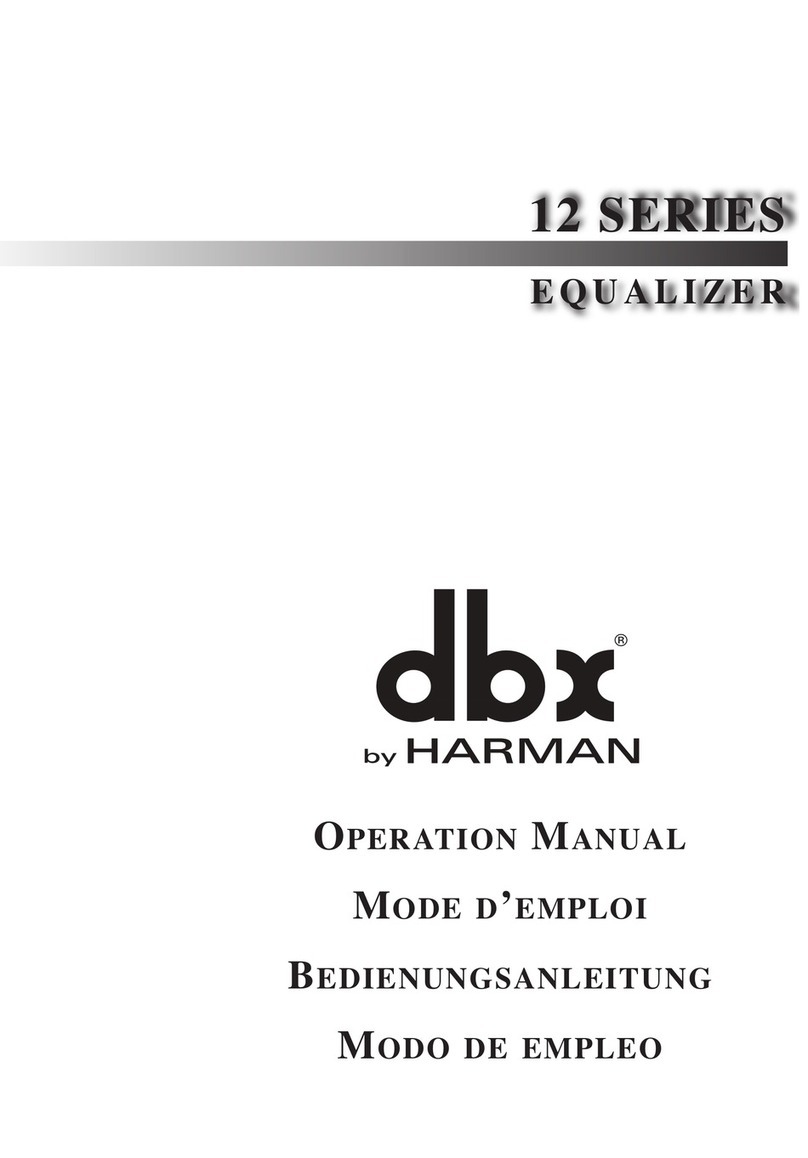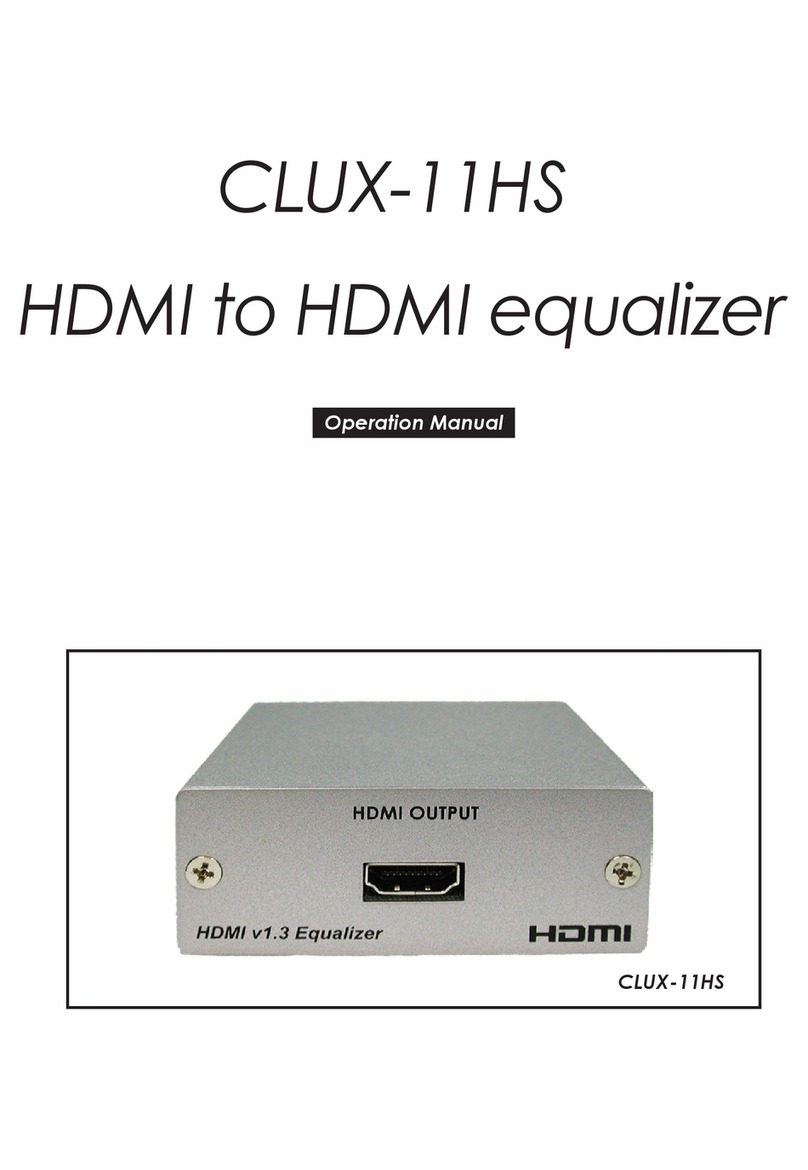Manley STEREO EQ User manual

OWNER'S MANUAL
LANGEVIN
MINI MASSIVE
STEREO EQ
MANLEY LABORATORIES, INC.
13880 MAGNOLIA AVE.
CHINO, CA. 91710
TEL: (909) 627-4256
FAX: (909) 628-2482
http://www.manleylabs.com
email: emanley @ manleylabs.com
email: service @ manleylabs.com
Rev. MSMPXxxxx
MANLEY
LABORATORIES, INC.

CONTENTS
SECTION PAGE
INTRODUCTION 3
BACK PANEL & CONNECTING 4
FRONT PANEL 5,6,7,8
CREDITS 8
THE MASSIVE PASSIVE
BEGINNINGS, THE SUPER PULTEC 9
THE PASSIVE PARAMETRIC 10
WHY PASSIVE, WHY PARALLEL 11
PHASE SHIFT, WHY TUBES 12
CURVES 13 to16
TUBE LOCATIONS, ETC 17, 18
EQUALIZING
EQUALIZERS (GENERAL) 19
EQUALIZER TECHNIQUES 20 to 24
TRANSLATIONS 25
TROUBLESHOOTING 26, 27
MAINS CONNECTIONS 28
SPECIFICATIONS 29
WARRANTY 30
WARRANTY REGISTRATION 31
APPENDIX 1 - EXAMPLE SETTINGS 32
APPENDIX 1 - TEMPLATE FOR STORING SETTINGS 33

INTRODUCTION
3
THANK YOU!...
for choosing the Langevin MINI MASSIVE STEREO EQUALIZER. This Equalizer is based on the
Manley Massive Passive Stereo Tube EQ and might be described as an evolution and an alternative to the
original.The Massive Passive and the Mini Massive share a number of qualities. Both are based on passive
circuits comprised of resistors, capacitors and inductors to sculpt tone, in fact for the most part, the exact
same circuits. These EQ circuits substantially attenuate the signal, and gain is needed to restore signal
levels to nominal unity gain when ‘flat’ and provide the apparent EQ boosts. The Massive Passive uses
mostly tubes to provide the gain and the Mini Massive uses solid-state gain blocks. The Massive uses
tubes and transformers simply because it was designed for a certain amount of color and character. The
Mini Massive was designed to be clean and pristine and be an alternative for people wanting the magic
of the its big brother, but who generally prefer EQs that have less intrinsic color.
The Massive Passive was intended to be a brute-force EQ in the same vein as classic vintage units,
most useful on close-miked instruments needing some drastic treatment. Like many things, the users
found many applications that the designer had not expected, such as stereo buss, mastering and subtle
vocal treatments. The Mini Massive should be even better suited for these tasks for some people,
because of its basic cleanliness and more minimalist design. Of course, the best choice is at least one
of each, plus a good analog parametric, a familiar vintage EQ, plus a few good digital EQs, including
a linear phase type.
Some sections of this manual have been directly 'borrowed' from the Massive Passive manual and some
parts are fresh and only pertain to the Mini Massive. As usual, the manual is mostly just train-of-thought,
random ramblings from one engineer to another and can be read with a grain of salt or a smile.
GENERAL NOTES
LOCATION & VENTILATION
The Langevin MINI MASSIVE must be installed in a stable location with ample ventilation. It is
recommended, if this unit is rack mounted, that you allow enough clearance on the top of the unit such
that a constant flow of air can move through the ventilation holes. Airflow is primarily through the top.
You should also not mount the MINI MASSIVE where there is likely to be strong magnetic fields such
as directly over or under power amplifiers or large power consuming devices. The other gear's fuse values
tend to give a hint of whether it draws major power and is likely to create a bigger magnetic field. Magnetic
fields might cause a hum in the EQ and occasionally you may need to experiment with placement in the
rack to eliminate the hum. In most situations it should be quiet and trouble free.
WATER & MOISTURE
As with any electrical equipment, this equipment should not be used near water or moisture.
SERVICING
The user should not attempt to service this unit beyond that described in the owner's manual.
Refer all servicing to your dealer or Manley Laboratories. The factory technicians are available for
card! Check the manual - Your question is probably anticipated and answered within these pages......

First connect all the cables, then turn on the power, wait 30 seconds, then have fun, as if we had to tell you....
1) POWER CONNECTOR. First verify the POWER SWITCH on the front panel is off (down). Use the power cable supplied with your
Massive Passive. One end goes here and the other end goes to the wall outlet. You know all this.
2) VOLTAGE LABEL (ON SERIAL STICKER). Just check that it indicates the same voltage as is normal in your country. It should
be. If it says 120V and your country is 220V, then call your dealer up. If it says 120V and you expect 110 it should work fine.
3) FUSE. The fuse holder on this unit is part of the IEC power connector and can be accessed by flipping the small rectangular panel. Before
attempting this be sure the power cable is removed to ensure there is no possibilty of getting shocked As to be expected, the big hint that
the fuse is blown is that there seems to be no power, no LEDs lit no matter where the switches are set, in other words the same smptoms
as the power cable not being plugged into the wall or the Mini Massive (which should be the first thing to check). Fuses are meant to "blow"
when an electrical problem occurs and are essentially safety devices to prevent fires, shocks and big repair bills. Only replace it if it has
"blown" and only with the same value and type (2A slow-blow for 120V, 1A slow-blow for 220V). A blown fuse either looks blackened
internally or the little wire inside looks broken. Because the Mini Massive automatically goes into "hard-wire bypass" when power is
removed audio will pass through the unit even when there is a blown fuse.
4) Fuse Value. Just in case you don't read manuals (including this one obviously) we remind you of the right value of fuse to use on the
back panel. In fact, there are a few other bits of technically marginally useful info on the back panel that you may refer to occasionally.
5) Input / Output Level Switch. This 3 position toggle is important to set properly. It allows you to properly interface the Mini Massive
with your studio. For most situation the default setting will be the center position "+4 Balanced" that should work with most pro gear. The
other settings are "+4 Unbalanced" and "-10 Unbalanced". In most situations, especially with typical balanced audio gear, when this switch
is improperly set, the symptoms are subtle, with only a loss of headroom being the significant factor. If in doubt, set this switch to the middle
position and read the section on page 25 for a more complete explanation.
6) COMBO JACK INPUTS. Accepts balanced or unbalanced and XLR or 1/4 inch Tip-Sleeve or Tip-Ring-Sleeve plug sources. These
are just the Input jacks and will easily interface with most gear.
7) XLR JACK OUTPUTS. These are the basic output jacks and should easily interface with virtually any audio equipment whether
balanced or unbalanced when the appropriate setting is chosen at the Input / Output Level Switch. Pin 1 is Ground, Pin 2 is hot or + and
Pin 3 is low or -. These outputs are not the typical pseudo-balanced or cross-coupled type which automatically compensate for unbalanced
inputs but are often unstable and may significantly reduce hum rejection. These outputs maintain a constant and very balanced output
impedance regardless of loading conditions.
8) Transformer Option Switch. Mini Massives may have the "Transformer Option" installed and part of the option includes the fitting
of this switch. If the switch is not here then the "Transformer Option" is not installed. With the switch in the lower position, the transformer
is bypassed and the output is direct coupled from the line drivers. The advantage is a wider frequency response, extending from 1 Hz to
100 kHz, and slighly lower distortion or less color. With the switch in the center position the output goes through the transformer. The
advantages include "Floating" outputs which are very forgiving when it comes to interfacing and the slightly warmer and smoother color
caused by the transformer. The transformer sound in this case is deliberately exagerated a little just because we all expect a bit of tonal
change,and in truth when this transformer is used raw the difference sonically may be too subtle to justify its inclusion, so the circuit pushes
it for extra color . The upper position of the switch further exagerates the transformer by biasing a separate winding with enough DC current
to increase the even order distortions and is intented to begin to simulate some Class A discrete British console circuits from the mid 70's.
This position may seem to increase the apparent lows especially as the user increases the low boosts on the front panel. It may be too much
for some purposes and may be most appropriate where a little less fidelity may be desired - rock guitars for example.
Maybe it might be worth pointing out to those with less time behind the soldering irons and oscilloscopes, that modern transformers tend
to be a lot more transparent than marketing suits may want you to believe (remember when "tubes make it warm" was the hype). We pointed
out that it was more like the old transformers that gave that vintage warmth and now this is the new hype. Basically, some old (and new)
transformers used cheap steel (low permeability) laminations and this caused some low freq distortions. Of course, any distortion can be
said to both be useful on some things but a disaster on other sounds. Its not platinum record magic, its just familiar distortions. OK?
4
THE BACK PANEL
BYPASS
N9512423
OUTPUT
CHANNEL 2
www.manleylabs.com
INPUT OUTPUT
LEVELS
IRON
TRANSFORMER
OPTION
VINTAGE
INPUT INPUT
CHANNEL 1
13880 MAGNOLIA AVE., CHINO, CA 91710
MANLEY LABS
MINI-MASSIVE
BY MANLEY LABS
OUTPUT
VOLTAGE
FUSE 1A @ 117V
FUSE .5A @ 220V
DO NOT OPEN. REFER SERVICING TO
MINI MASSIVE
DESIGNED BY HUTCH
TWO CHANNEL EQUALIZER
PHONE (909) 627-4256 fax (909) 628-2482
IF IN DOUBT USE +4 BALANCED
& “IRON” IF OPTION IS INSTALLED
+4 UNBALANCED
-10 UNBALANCED
+4
BAL
PIN 1 GROUND
PIN 2 HOT +
PIN 3 LOW -
SERIAL NUMBER
QUALIFIED PERSONNEL ONLY
CAUTION - RISK OF ELECTRIC SHOCK
123
5
66
778 4

1) The Power Switch: First things first, flip the toggle up to turn on the Mini Massive. There is no "power on LED", instead
the "Bypass" LED indicator is lit red for a few seconds as the unit warms up and stabilizes. If the "EQ IN" switch is also up,
then a few seconds later the LED changes from red to green. The Mini Massive has a "hard-wire bypass" so even when power
is off it will pass audio untouched. In fact, because this EQ is quite transparent when set flat, one of our tests is cycling power
on and off while listening for any audible change - it should be as transparent through the unit as when hardwire bypassed.
2) EQ IN toggle: This activates both sides of the EQ and is intended as a convenience feature. Of course, it is pretty easy to
bypass the two individual sections per side using the "OUT" setting (Switch#3) so one can easily use the unit as two mono
EQs. This master EQ IN switch makes auditioning and comparing the effect of the total stereo EQ extremely easy.
3) BOOST / OUT / CUT, TOGGLE. Each band has individual toggles to select whether that band will boost or cut or be
bypassed. "OUT" is a hardwire bypass for that band. Unlike most EQs, you must select boost or cut for each band. There are
several good reasons for this arrangement. First, because the boost part of the circuit is in a different place than the cut part
because it is passive, this allows us to use the same components in both sections but doing essentially opposite functions. The
conventional arrangement of a boost/zero/cut pot (baxandall) circuit was avoided to really make it passive. This switch also
allows twice the resolution of the "GAIN" pot and a much more accurate "zero". The center detent of conventional EQs is rarely
the "electrical" center of the pot so what you expect is zero is often a little EQed. This toggle allows some of us, who use dip
EQ to reduce offending frequencies to verify those frequencies in "Boost" and then switch to "Cut". Finally, it allows us to
bypass each band individually, without losing our "GAIN" pot setting rather than resetting a band to zero or bypassing the
entire EQ.
4) SHELF & BELL toggle. The two lowest (leftmost) bands can each be a special Low Shelf or conventional Bell shape. The
two highest (rightmost) bands can each be a special High Shelf or conventional Bell shape. Shelf & Bell describe the EQ's
shape. We included some diagrams to help visualize these curves. Bell curves focus their boost and cut at given frequency and
the further away we get from that frequency, the less boost or cut. The bell curves on the Mini Massive are moderately wide
and the "Bandwidth Control" does not have a lot of range and it also affects the maximum boost and cut (like a Pultec). Shelf
slopes generally boost (or cut) towards the highs or lows (thus high shelves and low shelves). These are not to be confused
with "high or low filters" which purely cut above or below a given frequency. Shelves also have gain or dB controls which
allow you to just boost or cut a little bit if desired - filters never have these controls.
The High band also has a special setting labelled BELL 2 that only operates on the 4 highest frequencies. It simply narrows
the Q for those 4 highest frequencies. This can be useful for controlling the apparent air or sweetness of the extreme highs.
One may notice the ovals marked around the 4 highest freqs and a corresponding oval around the Bell 2 setting.
It is a bit of an refinement from the Massive Passive which doesn't offer that feature and which followed a more general
philosophy of maintaining very similar curve shapes across the spectrum. While the SHELF curves on both the Massive
Passive and Mini Massive are capable of good control of 'air', it seems many users missed that idea because they generally
favor bell curves and in the case of the Massive Passive the bell Q is probably too wide for great 'air' control. The Mini Massive
includes 3 features that vastly improve 'air' control. The first is this narrower Q in Bell 2, the second is reshaped curves for
the 4 highest shelf frequencies, and the third is the incredible clarity offered by the Rapture amps along with transformerless
outputs, which extents the frequency and phase response. These features were considered important for a basic 2 band stereo
EQ more aimed at mastering than the Massive Passive was, where ironically it has seen a lot of use.
Similarly, we reshaped the 4 lowest shelf curves for more fatness, depth and punch compared to the Massivo. These new curves
might be considered more Pultec-like but are not in the strictest sense. They just offer a similar usefulness and essentially
increase the range that the bandwidth control can be effectively used for those lowest freqs. It also breaks away from the
philosophy on the Massivo of maintaining similar curve shaping across the spectrum. The Mini shifts the dip aspect of the shelf
curves more towards the low mids and mids for those lowest 4 frequencies.
It may also be worth pointing out that the shelf curves that were introduced by the Massive Passive were quite unique at that
time and while there have been imitations since, these shelves are still unique, unusual and certainly unconventional compared
to most EQs and are worth exploring and learning. Let us just say that the biggest fans of the Massive are the engineers who
quickly learned the strange shelf 'features' and those who approached it as a whole new tool, and not just a standard EQ.
5
THE FRONT PANEL
mini
BY MANLEY LABS
FREQUENCY
22
33
47
68
100
150
220
330
470
680
1K
LEVEL
0
8
20
P
B
massive
BOOST
OUT
CUT
LOW FREQUENCY EQ
BANDWIDTH
SHELF
BELL
560
820
1K2
1K8
2K7
3K9
5K6
8K2
12K
16K
27K 22
33
47
68
100
150
220
330
470
680
1K 560
820
1K2
1K8
2K7
3K9
5K6
8K2
12K
16K
27K
FREQUENCY BANDWIDTH LEVEL
BOOST
OUT
CUT
SHELF
BELL 2
SHELF
BELL
SHELF
BELL 2
FREQUENCY BANDWIDTH LEVELFREQUENCY BANDWIDTH LEVEL
BOOST
OUT
CUT
BOOST
OUT
CUT
HI FREQUENCY EQ HI FREQUENCY EQLOW FREQUENCY EQ
0
8
20
P
B0
8
20
P
B
0
8
20
P
B
EQ IN
POWER
BELL
BELL
HZ HZ HZ HZ
1
233
446
3
4
3
457657657657

5) GAIN. This sets the boost and/or cut depth or amount and works with the BOOST, OUT, CUT, TOGGLE. FLAT is fully
counter-clockwise not straight up "12:00" like most EQs. It is more like a Pultec in this regard. Maximum boost or cut is fully
clockwise and can be up to 20 dB - but not necessarily. There is a fair amount of interaction with the BANDWIDTH control.
The maximum of 20 dB is available in Shelf modes when the Bandwidth is CCW and is about 12 dB when the Bandwidth is CW.
The maximum of 20 dB is available in Bell modes when the Bandwidth is CW and is about 6 dB when the Bandwidth is CCW.
At straight up "12:00" in Bell mode "narrow" expect about 8 dB of boost or cut. In other words, you shouldn't expect the markings
around the knob to indicate a particular number of dBs. Many Eqs are this way. On the other hand, this interaction is the result
of natural interactions between components and tends to "feel" and sound natural as opposed to contrived.
The 2 bands will have some interaction and interdependence especially when both are set towards mid frequencies. It is a parallel
EQ rather than the far more common series connected style. If you set up all 2 bands to around 1kHz and boosed each 20 dB,
the total boost will be 20 dB rather than 40dB (20+ db of boost and 20 dB into clipping). This also implies, that if you first boost
one band, that the next will not seem to do much if it is at similar frequencies and bandwidths. Virtually all other parametrics
are both series connected and designed for minimal interaction, which seems to be quite appealing if you wear a white lab coat
with pocket protectors ;.) Actually, there are valid arguements for those goals and there are definately some applications that
require them. However, there is also a valid point for an EQ that is substantially different from the "norm", and for audio toys
that have artistic merit and purpose and not just scientific interest or gimmickry. We tried to balance artistic, technological and
practical considerations in both the Massive Passive and Mini Massive, and offer both some new and old approaches that appealed
to the ears of recording engineers (and our own ears).
6) BANDWIDTH. Similar to the "Q" control found in many EQs. A more accurate term here would be "Damping" or
"Resonance" but we used "Bandwidth" to stay with Pultec terminology and because it is a "constant bandwidth" (*) design rather
than "constant Q" and because of the way it uniquely works in both Bell and Shelf modes. In Bell modes, you will find it similar
to most Q controls with a wider shape fully CCW and narrower fully CW. The widest Q (at maximum boost) is about 1 for the
and the narrowest Q is about 2.5 to 3 for most of the frequencies. On paper, the bell widths appear to have less effect than is
apparent on listening and the sound is probably more due to "damping" or "ringing" and the way it interacts with the gain. Also
some people associate a wide bell on conventional EQs with more energy boost or cut, and at first impression the Massivo seems
to work backward compared with that and narrow bandwidths give more drastic results. On the Massive Passive a narrow
bandwidth bells will allow up to the full 20 dB of boost (or cut) and wide bandwidths significantly less at about 6 dB maximum.
In Shelf Modes the Bandwidth has a special function. When this knob is fully CCW, the shelf curves are very similar to almost
all other EQs. As you increase the Bandwidth control, you begin to introduce a bell curve in the opposite direction. So if you
have a shelf boost, you gradually add a bell dip which modifies the overall shelf shape. At straight up, it stays flatter towards the
mid range, and begins to boost further from the mids with a steeper slope but the final maximum part of the boost curve stays
relatively untouched. With the Bandwidth control fully CW, that bell dip becomes obvious and is typically 6dB down at the
frequency indicated. The boost slope is steeper and the maximum boost may be about 12 dB. These curves were modelled from
Pultec EQP1-As and largely responsible for the outrageous "phatness" they are known for. As you turn the Bandwidth knob (CW),
it seems as if the shelf curve is moving further towards the extreme frequencies, but mostly of this is just the beginning part of
the slope changing and not the peak. This also implies, that you may find yourself using frequencies closer to the mids than you
might be used to. These shelf curves have never been available for an analog high shelf before and provide some fresh options.
7) FREQUENCY. Each band provides a wide range of overlapping and interleaving frequency choices. Each switch position
is selecting a different capacitor and inductor. In fact, in SHELF mode the EQ could be deemed third order sections, which implies
3 frequency dependent components are in play, 2 capacitors and an inductor or two inductors and a capacitor. Normal shelf EQs
are first order with only one capacitor creating the EQ shape, and this shape is less steep and controllable by the user.
At extreme high and low frequencies (including 10K and 12K), you might get some unexpected results because of the Bandwidth/
Shelf function. For example, you can set up 20 dB of boost at 12K and it can sound like you just lost highs instead of boosting.
This happens when the Bandwidth control is more CW only and not when it is CCW. Why? You are creating a dip at 12K and
the shelf is only beginning at the fringes of audibility but the dip is where most of us can easily percieve. It takes a little getting
used too the way the controls interact. The reverse is also true, where you set up a shelf cut and you get a boost because of the
Bandwidth control being far CW. In some ways this simulates the shape of a resonant synthesizer filter or VCF except it doesn't
move. These wierd highs are useful for raunchy guitars and are designed to work well with the Filters. There are a lot of creative
uses for these bizarre settings including messing up the minds of back-seat engineers.
6

NOTES
1) Do not assume the knob settings "mean" what you expect they should mean. Part of this is due to the interaction of the controls. Part
is due to the new shelf slopes and part due to a lack of standards regarding shelf specification.
2) You may find yourself leaning towards shelf frequencies closer to the mids than you are used to and the "action" seems closer to the edges
of the spectrum than your other EQs. Same reasons as above.
3) You may also find yourself getting away with what seems like massive amounts of boost. Where the knobs end up, may seem scarey
particularly for mastering. Keep in mind that, even at maximum boost, a wide bell might only max out at 6 dB of boost (less for the lowest
band) and only reaches 20 dB at the narrowest bandwidth. On the other hand, because of how transparent this EQ is, you might actually
be EQing more than you could with a different unit. Taste rules, test benches don't make hit records, believe your ears.
4) Sometimes the shelfs will sound pretty wierd, especially (only) at the narrow bandwidth settings. They might seem to be having a complex
effect and not only at the "dialed in" frequency. This is certainly possible. Try wider bandwidths at first.
5)A reasonable starting point for the Bandwidth for shelves is straight up or between 11:00 and 1:00. It was designed this way and is roughly
where the maximum flatness around the "knee" is, combined with a well defined steep slope.
6) The back panel I/O level switch is important to set properly in order to maximise headroom and ensure that there is not an unwanted
6 dB level loss. However, there may be situations where a deliberate goal might be to make the Mini Massive clip early. For example, one
could use the "+4 UNBALANCED" setting (assuming it is patched into balanced gear) and get 6 dB less headroom or use the "-10
UNBALANCED" setting which will clip the input 12 dB early.
7) And speaking of clipping, there are no "Clip LEDs" mostly because like the Massive Passive, the headroom is generally outrageous. For
example the balanced output clips at +30 dBm which is about 6 dB more than most gear and 8-10 dB more than most A to D converters.
That said, one still needs to always be listening and should be aware that clipping may be possible with extreme settings.
8) The Mini Massive may sound remarkably different from other high end EQs and completely different from the console EQs. Yes, this
is quite deliberate. Hopefully it sounds better, sweeter, more musical and it complements your console EQs. We saw little need for yet
another variation of the standard parametric with only subtle sonic differences. We suggest using the Mini Massive before tape, for the
bulk of the EQ tasks and then using the console EQs for some fine tweaking and where narrow Q touch-ups like notches are needed. The
Mini Massive is equally at home doing big, powerful EQ tasks such as is sometimes required for tracking drums, bass and guitars, or for
doing those demanding jobs where subtlety is required like vocals and mastering.
9) Of course the Mini will get compared to the Massive Passive which gets compared to vintage Pultecs and to Manley's Enhanced Pultec
EQs so maybe a few words from the designer are appropriate. First things first - The vintage Pultec EQ section was designed by Western
Electric and decades later Eugene Shenk added his gain stage and formed a company called Pulse Technologies to manufacture these EQs.
Shenk's design used 4 triodes (2 tubes) in a balanced topology and 3 transformers, and we might point to the interstage transformer and
less than optimal drive circuitry for its vintage Pultec crunch . This made it a favorite for kick and sometimes bass guitar during the 70's
and 80's but may have been too low fidelity to be used on much else. Of course, most Pultecs by that time had drifted to the point where
if one had 10, one was lucky if two sounded similar enough for stereo. The Manley Pultecs were designed initially for mastering and a
cleaner gain stage was used and transformers were chosen that were flatter and cleaner and more consistant. Of course, the exact values
of the original EQ components were used, but the quality of capacitors, resistors and pots had improved and were used. So the original EQ
shapes are intact along with several new frequencies added. Pultecs have been a studio and broadcast standard since the 60's and that most
engineers used both the boost and cut knobs at the same time - so it may be a bit funny that what we call "the Pultec Curve" wasn't described
until the late 90's and wasn't resurrected earlier.
The Massive Passive was designed as a tracking EQ and as an alternative or addition to the usual tools like console EQs and plugs.
A) There were hundreds of op-amp based parametric EQs and a growing number of software based simulations of that idea. Even a Manley
variation on that idea wouldn't have been so different and we didn't want to use op-amps (but ended up using one in the end)
B) Nobody had really addressed the issue that most engineers favorite EQs were Neves, APIs and Pultecs and nobody had really done an
new inductor based EQ design in decades.
C) There was more of a percieved need for a new tracking EQ than a 'mastering EQ'. Besides back then there were a lot fewer people calling
themselves mastering engineers. The idea of strapping an EQ across the mix at that time was pretty unusual and almost unheard of.
D) So we set out to design an EQ that would be good for guitars, bass, keys and drums, and of course it ended up being used for almost
everything else (like vocals) and started a fashion of EQing the stereo buss (for better or worse).
The Mini Massive came about due to the designer finally finding a solid state gain stage he liked a lot (it was developed for an A/D converter)
and because he appreciated how the Massive came to be used and how that style of EQ might be improved for some users. Of course, some
use the Massive for its color and there was no need to repeat that (if that is what you need we still build the Massive). The Mini was envisioned
as a buss EQ so and was optimised for that (it is clean), so, of course, we expect it will get used for everything else.
8

More Thoughts from the Designer
Clean versus colored - Active versus Passive - Tape versus Digital - well it all gets a bit tiresome.
Here is the real deal: they are all a bit colored and for the most part remarkably clean. So if anything
we are basing our preferences on which flavor of subtle color we either happen to like, or believe we
need (based on something we read somewhere) which may be just a slightly familiar sound rather
than some magnificient life changing event. No magic, just good tools. The music is the magic.
Does Digital require some analog warmth, some color to make a great recording? Not necessarily.
For example some recordings call for "as clean as possible" and even some instruments within an
otherwise grungy mix may sound best or provide a wonderful contrast when made as clean as
possible. And while this designer doesn't claim that today's hi end digital is absolutely clean and
transparerent or clinical and sterile, adding more and more stages of processing whether analog or
digital will mostly tend to make it less transparent, less true to the source. Choose wisely.
Will some analog processor fix digital's flaws? This designer hears digital's flaws as a subtle form of
time smear. Much analog on the other hand can be characterized as having various forms of
harmonic and intermodulation distortion, plus often some time smear caused by phase shifts which
are practically inevitable given the normal frequency responses of audio gear. One form of distortion
doesn't cancel out the other and adding more time smear should make things worse. However, there
are some families of distortion that may be euphonic and either add to the effect of 3D depth, some
distortions give an effect of fatness or warmth (transformers), and some distortions that seem to
evoke vintage tone like a familiar smell. So 'as clean as possible' is appropriate for some situations
and somewhat controlled dirt is appropriate for others. Beware of getting the mind-set that either
goal is appropriate for every sound and every situation. Like every house should be the same color.
There are many situations where one might want a processor (or preamplifier) that doesn't leave its
thumbprint on the sound. Typically mastering is one place for a transparent EQ, especially when the
mix is already pretty damn fine. Other situations, of course include, most classical and live ensemble
or choir recordings, a lot of acoustic recordings, folk, country, jazz, choir, classical, etc. While the
MiniMassive does have very transparent gain stages, and the EQ sections are passive so they have
less artifacts at low to modereate settings than most op-amp based EQs, it should be pointed out that
significant drastic settings with any EQ (or compressor) regardless of how clean it started, will
probably leave a thumbprint. Sometimes 'natural' is very good goal, and it can be the most familiar.
The place to start is player, instrument, room then mic choice & position, preamp & converter. EQ?
With the MiniMassive, expect a generally clean and natural sound with conservative to moderate
settings. However, it will gradually introduce a signature color at more drastic settings. With the
transformer option, one can introduce some vintage color and subtle warmth. The downside with
iron, and there is always a downside, is some subtle time smear that might be noticed with sounds
that have lots of energy (and tightness) at the edges of the spectrum. Worth a check on big solid
mixes or kick drum tracks or high hat tracks. Drastic EQ settings (from any EQ) can 'time-smear'
too. EQ changes generally introduce phase shift so listen for time smear with spectrum changes.
And for those who have need for more color and more of that elusive vintage vibe, we designed
another EQ to do that function. It is called the Massive Passive, and it is a vacuum tube based unit
originally designed to be an alternative to the typical mostly boring EQs available then. Ya know?

Just a few notes for plug-in users.
One question that gets asked a lot is “Why no ‘Link’ switch “or “Why not a stereo EQ with one set
of controls?” The most accurate answer is “you guys are spoiled, ha ha”. To do it in digital is almost
a no-brainer and is just a matter of passing a few numbers to the other sides parameter registers. To
do it on an analog compressor is a bit more involved but still pretty easy and not pricey. But to do it
on an analog EQ, requires big expensive multi-deck switches, pots, and practically all audio
switching be done with relays or FETs. Now given that the rotary switches and all the pots are
already custom and difficult to source, getting ones that are twice as deep, 4 times rarer, and would
only be used occasionally, would add a lot of cost to the unit. Besides that, considering that the Mini
is really stuffed with parts, just routing printed circuit board traces, would be difficult and involve
compromises to the integrity. Which brings up the final point, crosstalk would probably bite one’s
butt for even trying. Basically, a stereo link or single set of knobs is way more difficult to do in
analog, and extremely easy in digital and that is the difference.
Next question…”Why no Manley EQ plug-in?” Maybe we are a bit too picky, but we haven’t heard
a plug in that really approximates the subtleties of an inductor based EQ or even a transformer.
Maybe some day, we’ll combine our knowledge with some DSP wizard’s knowledge and do
something cool, and cheap (which is really what you are asking for, right?). We might also say, that
we would prefer to do something new and different than try to clone our existing stuff. If and when
Manley does a plug-in it should be at least as radical and special as the hardware. In other words,
take advantage of digital technology and do what it can do best, rather than the questionable effort of
trying to recreate (again) analog processes especially if this is where digital technology is at its
weakest or most immature for now. However, like yourselves, we do use plug-ins, music programs,
etc, and evaluate too many to name, and we are keeping our ears and eyes open. Of course, some of
you know that the we have contributed to some non-Manley plug-ins that are highly regarded.
Meanwhile progress continues and we are continuing to listen, and maybe some day we'll hook up
with some adventurous DSP hot shots with more on their minds than "clone market $".
Or this question…” Have you guys thought about digital controlled analog so that maybe we can
control the EQ like a plug-in and automate or even recall settings?” Gee, we would love to but…..
we, as an industry, just don’t have the technology yet that would enable that without compromising
the signal integrity (and do it at a reasonable cost). For us, that has to be a prime consideration, and
it is really why most of our customers come to Manley. We’ve been approached by a few companies
asking to put our front panels on a computer screen for recalls, but none have suggested any reason
why that would be better or more accurate or cheaper than a pencil and paper, especially when we
supply a paper template in the back of the manual. So, our decisions are based on why people buy
our stuff, which is usually the quality and sound rather than feature set and buzz words.
Or the big question…”Why do analog EQs sound better or at least different than my 50 plug-ins?”
Maybe DSP guys trying to model analog, have zero experience with analog. Maybe young guys who
haven’t yet developed their ears are developing audio software. Maybe FIR filters used everywhere
in digital audio might be a little more audible than people presume. Maybe human hearing and both
analog and digital processing are deeper topics than most people believe and all of us are still
learning. The good news is that the difference is narrowing every year and maybe some day the
choice will be mostly whether this signal path is analog or digital or the order that you prefer to
process or whether you prefer LCD screens or physical knobs and switches.

Beginnings
The very earliest equalizers were very simple and primitive by
todays standards. Yes, simpler than the hi-fi "bass" and "treble"
controls we grew up with. The first tone controls were like the tone
controls on an electric guitar. They used only capacitors and
potentiometers and were extremely simple. Passive simply means
no "active" (powered) parts and active parts include transistors,
FETs, tubes and ICs where gain is implied. "Passive" also implies
no boost is possible - only cut. The most recent "purely passive EQ"
we know of was the EQ-500 designed by Art Davis and built by a
numberofcompaniesincludingUnitedRecordingandAltecLansing.
It had a 10 dB insertion loss. No tubes. It had boost and cut positions
but boost just meant less loss. Manley Labs re-created this vintage
piece and added a tube gain make-up amp for that 10 dB or make-
up gain to restore unity levels. It has a certain sweetness too.
You have probably heard of passive crossovers and active crossovers
in respect to speakers or speaker systems. Each has advantages.
Almost all hi-fi speakers use a passive crossover mounted in the
speaker cabinet. Only one amp is required per speaker. Again,
passive refers to the crossover using only capacitors, inductors and
resistors. Active here refers to multiple power amplifiers.
One of the main design goals of the Massive Passive was to use only
capacitors, inductors and resistors to change the tone. Pultecs do it
this way too and many of our favorite vintage EQs also relied on
inductors and caps. In fact, since op-amps became less expensive
than inductors, virtually every EQ that came out since the mid '70's
substituted ICs for inductors. One is a coil of copper wire around a
magnetic core and the other is probably 20 or more transistors. Does
the phrase "throwing out the baby with the bath water" ring a bell?
Another design goal was to avoid having the EQ in a negative
feedback loop. Baxandall invented the common circuit that did this.
It simplified potentiometer requirements, minimised the number of
parts and was essentially convenient. Any EQ where "flat" is in the
middle of the pot's range and turning the pot one way boosts and the
other way cuts is a variation of the old Baxandall EQ. Pultecs are not
this way. Flat is fully counter-clockwise. For the Massive Passive,
Baxandall was not an option. The classical definition of "passive"
has little to do with "feedback circuits" and we are stretching the
definition a bit here, however, it certainly is more passive this way.
We only use amplification to boost the signal. Flat Gain ! What goes
in is what comes out. If we didn't use any amplifiers, you would need
to return the signal to a mic pre because the EQ circuit eats about 50
dB of gain. Luckily, you don't have to think about this.
We visited a few top studios and asked "what do you want from a
new EQ ?" They unanamously asked for "click switch frequencies",
"character" rather than "clinical" and not another boring, modern
sterile EQ. They had conventional EQs all over the console and
wanted something different. They had a few choice gutsy EQs with
"click frequencies" that were also inductor/capacitor based (which
is why the frequencies were on a rotary switch). Requests like
"powerful", "flexible", "unusual" and "dramatic" kept coming up.
We started with these goals: modern parametric-like operation,
passive tone techniques through-out, and features different from
anything currently available and it had to sound spectacular.
"The Super-Pultec"
Manley Labs has been building a few versions of the Pultec-style
EQs for many years as well as an updated version of the EQ-500
(another vintage EQ). These are classic passive EQs combined with
Manley's own gain make-up amplifiers. Engineers loved them but
we often heard requests for a Manley Parametric EQ with all the
modern features but done with tubes. Another request we had was
for a "Super-Pultec". We briefly considered combining the "best of"
Pultecs into a new product but the idea of some bands only boosting
and some only cutting could only be justified in an authentic vintage
re-creation and not a new EQ.
The next challenge was to make an EQ that sounded as good or better
than a Pultec. With all the hundreds of EQs designed since the
Pultec, none really beat them for sheer fatness. We knew why. Two
reasons. EQP1-A's have separate knobs for boost and cut. People
tend to use both at the same time. You might think that this would
just cancel out - wrong.... You get what is known as the "Pultec
Curve" . The deep lows are boosted, the slope towards "flat"
becomes steeper, and a few dB of dip occurs in the low mids. The
second reason for the fatness and warmth was the use of inductors
and transformers that saturate nicely combined with vacuum tubes
for preserving the headroom and signal integrity.
Could we use a "bandwidth control" to simulate the "Pultec Curve(s)?
The Pultec curve is officially a shelf and shelf EQs don't have a
"bandwidth or Q knob"- only the bell curves. So, if we built a passive
parametric where each band could switch to shelf or bell and used
that "bandwidth" knob in the shelf modes we could not only simulate
the Pultecs but add another parameter to the "Parametric EQ" We
found that we could apply the "Pultec Curve" to the highs with
equally impressive results. This is very new.
The Massive Passive differs from Pultecs in several important areas.
Rather than copy any particular part of a Pultec, we designed the
"Massivo" from the ground up. As mentioned, each band being able
to boost or cut and switch from shelf to bell is quite different from
Pultecs. This required a different topology than Pultecs which like
most EQs utilize a "series" connection from band to band. The
Massive Passive uses a "parallel" connection scheme.
A series connection would imply that for each band's 20 dB of boost,
there is actually 20 dB (more in reality) of loss in the flat settings.
Yeah, that adds up to over 80 dB, right there, and then there is
significant losses involved if one intends to use the same components
to cut and to boost. And more losses in the filter and "gain trim". That
much loss would mean, that much gain, and to avoid noise there
would need to be gain stages between each band and if done with
tubes would end up being truly massive, hot and power hungry.
Instead, we used a parallel topology. Not only are the losses much
more reasonable (50 dB total!) but we believe it sounds more
"natural" and "musical". In many ways the Massive Passive is a very
unusual EQ, from how it is built, to how it is to operate and most
importantly how it sounds.
We designed these circuits using precise digital EQ simulations,
SPICE3 for electronic simulations, and beta tested prototypes in
major studios and mastering rooms for opinions from some of the
best "ears" in the business.
9
This section is borrowed from the Massive Passive Manual

Another important concept. When you use the shelf curves the
frequencies on the panel may or may nor correspond to other EQ's
frequency markings. It seems there are accepted standards for filters
and bell curves for specifying frequency, but not shelves. We use a
common form of spec where the "freq" corresponds to the half-way
dB point. So, if you have a shelf boost of 20 db set at 100 Hz, then
at 100, it is boosting 10 dB. The full 20 dB of boost is happening
until below 30 Hz. Not only that, like every other shelf EQ there will
be a few dB of boost as high as 500 Hz or 1K. This is all normal,
except.........
Except we now have a working "bandwidth control" in shelf mode.
With the bandwidth set fully counter-clockwise, these shelves
approximate virtually ever other EQ's shelf (given that some use a
different freq spec). As you turn the bandwidth control clockwise,
everything changes and it breaks all the rules (and sounds awesome).
Lets use an example. If graphs are more your style, refer to these as
well. Suppose we use 4.7K on the third band by switching to "boost"
and "shelf" and turning the "bandwidth control" fully counter-
clockwise. Careful with levels from here on out. Just for fun, select
4.7kHz and turn the "dB" control to the max - fully clockwise. This
should be like most other shelf EQs, except with better fidelity, (if
you can set them to around 5 kHz!) . Now, slowly turn the
"bandwidth" clockwise. Near 12:00 it should be getting "special". It
also sounds higher (in freq). Keep turning. At fully clockwise it
seems to have gotten a little higher and some of the sibilance is
actually less than in "bypass". It sort of sounds as if the bandwidth
is acting like a variable frequency control but better. More air - less
harshness.
Compared to "conventional parametrics" in all their variations, the
Massive Passive has just "upped the ante" by adding a few useful
new parameters. The first is the use of the "bandwidth" in shelf
modes. Second is the ability to switch each and every band into shelf.
The original parametrics were only "bell". We have seen some EQs
that allow the lowest and highest bands to switch to shelf. Now you
can use two HF shelfs to fine tune in new ways without chaining
several boxes together. Lastly, each band can be bypassed or
switched from boost to cut without losing a knob setting. This allows
twice the resolution from the "dB" pots and allows one to exagerate
an offending note in order to nail the frequency easier, then simply
switch to "cut". You can always check, without losing the dB setting
by switching back to "boost" for a minute. You can also have
absolute confidence that the "zero" position on the dB pot is "flat"
which is not the case with center detented pots. Mechanical center
and electrical center are rarely the same.
"The Passive Parametric"
For years, we had been getting requests for a Manley parametric
equalizer, but it looked daunting because every parametric we knew
of used many op-amps and a "conventional parametric" would be
very impractical to do with tubes. Not impossible, but it might take
upwards of a dozen tubes per channel. A hybrid design using chips
for cheapness and tubes for THD was almost opposite of how
Manley Labs approaches professional audio gear and tube designs.
Could we combine the best aspects of Pultecs, old console EQs and
high end dedicated parametric EQs?
What is the definition of a "Parametric Equalizer"? We asked the
man who invented the first Parametric Equalizer and coined the
term. He shrugged his shoulders and indicated there really is no
definition and it has become just a common description for all sorts
of EQs. He presented a paper to the AES in 1971 when he was 19.
His name is George Massenburg and still manufactures some of the
best parametric EQs (GML) and still uses them daily for all of his
major recordings. Maybe he originally meant "an EQ where one
could adjust the level, frequency and Q independently". He probably
also meant continuously variable controls (as was the fashion) but
this was the first aspect to be "modified" when mastering engineers
needed reset-ability and rotary switches. The next development was
the variation of "Constant Bandwidth" as opposed to "Constant Q"
in the original circuits. "Constant Q" implies the Q or bell shape
staysthe same at every setting of boost and cut. "Constant Bandwidth"
implies the Q gets wider near flat and narrower as you boost or cut
more. Pultecs and passive EQs were of the constant bandwidth type
and most console EQs and digital EQs today are the constant
bandwidth type because most of us prefer "musical" over "surgical".
Lately we have seen the word "parametric" used for EQs without
even a Q control.
We can call the Massive Passive a "passive parametric" but .... it
differs from George's concepts in a significant way. And this is
important to understand, to best use the Massive Passive. The dB
and bandwidth knobs are not independent. We already noted that the
Q of the bell curve widens when the dB control is closer to flat. More
significantly, the boost or cut depth varies with the bandwidth
control. At the narrowest bandwidths (clockwise) you can dial in 20
dB of boost or cut. At the widest bandwidths you can only boost or
cut 6 dB (and only 2 dB in the two 22-1K bands). Somehow, this still
sounds musical and natural. The reason seems to be, simply using
basic parts in a natural way without forcing them to behave in some
idealized conceptual framework.
"Normal Shelf" Wide Bandwidth
"Special Shelf" Medium Bandwidth
"Pultec Shelf" Narrow Bandwidth
Bell Cut Narrow Bandwidth
"SPICE" printout
10

And Why Parallel?
The Massive Passive is a "parallel design" as opposed to the
far more common "series design". A few pages back, we
mentioned the main reason for going with a parallel design
was to avoid extreme signal loss, which would require extreme
gains and present the problem of noise or extreme cost. The
parallel approach not only avoided this but has a number of
advantages as well.
With the series EQ design, if you set 3 bands to boost the same
frequency 15 dB each, the total boost will be band one plus
two plus three - or 45 dB - but then it would probably be
distorting in a rather ugly way. With the Massive Passive, you
can dial in 4 bands to boost 20 db near 1K and it still will only
boost 20 dB total. If you tend to boost 4 bands at widely
separated frequencies (like what happens on two day mixes
with sneaky producers), it tends sound almost flat, but louder.
Other EQs seem to sound worse and worse as you boost more
and more. For some people it will act as a "safety feature" and
prevent them from goofy EQ. Occasionally, you may be
surprised with what looks like radical settings and how close
to flat it sounds. A side effect is that if you are already boosting
a lot of highs in one band, if you attempt to use another band
to tweak it, the second band will seem rather ineffective. You
may have to back off on that first band to get the desired tone.
You actually have to work at making the Massive Passive
sound like heavy-handed EQ by using a balanced combination
of boosts and cuts. In a sense it pushes you towards how the
killer engineers always suggest to use EQs (ie gentle, not
much, more cut than boost). This is good.
While there may be interesting arguments against any
interaction between EQ bands, the reasons tend to be more for
purely technical biases than based on listening. In nature and
acoustics and instrument design, very little of the factors that
affect tone are isolated from each other. Consider how a
guitar's string vibrates the bridge which vibrates the sound
board, resonates in the body, and in turn vibrates the bridge
and returns to the string. What is isolated? The fact that the
bands are NOT isolated from each other in the Massivo is one
of the reasons it does tend to sound more natural and less
electronic. We noticed this effect in a few passive graphic
EQs, notably the "560" and a cut-only 1/3 octave EQ.
There is a type of interaction we did avoid. That is inductor to
inductor coupling. It is caused by the magnetic field created
by one inductor to be picked up by another. It can cause the
inductors to become an unexpected value, or if it is band to
band, can cause effects that can best be described as goofy. In
the Filter Section we utilized close inductor spacing to get
some hum-bucking action but avoid magnetic coupling with
careful positioning. Some kinds of interaction suck and some
are beneficial.
Why Passive?
If you hate tech talk, just skip this section - it has to do with
electronic parts and circuits and design philosophy.
All EQs use capacitors. They are very easy to use, predictible,
cheap and simple. Some sound slightly better than others.
Inductors do almost the mirror function of capacitors.
Unfortunately, they can be difficult to use (they can pick up
hum), they can be difficult to predict (the essential inductance
value usually depends on the power going through them
which varies with audio), they are expensive and generally
have to be custom made for EQs. These are qualities that lab-
coat engineers tend to scowl at. Some effort was aimed at
replacing the poor inductors and more effort made to bad-
mouth them and justify these new circuits. The main reason
was cost. All of the "classic" Eqs used real inductors and that
has become the dividing line "sought after vintage" and just
old.
What the lab-coats didn't consider was that inductors may
have had real but subtle advantages. Is it only obvious to
"purists" that a coil of copper wire may sound better than 2 or
3 op-amps, each with over twenty transistors, hundreds of dBs
of negative feedback along with "hiss", cross-over distortion
and hard harsh clipping?
We mentioned the inductance value can change with applied
power. This also turns out to be a surprising advantage. For
example, in the low shelf, with heavy boosts and loud low
frequency signals, at some point, the inductor begins to
saturate and loses inductance. Sort of a cross between an EQ
and a low freq limiter. The trick is to design the inductor to
saturate at the right point and in the right way.
In the mid-bands and bell curves a somewhat different effect
happens. The center-frequency shifts slightly depending on
both the waveform and signal envelope. This "sound" is the
easily recognizeable signature of vintage EQs. It is not a type
of harmonic distortion (though it can be mistaken for this on
a test-bench) but more of a slight modulation effect.
Inductors in the form of transformers are also a large part of
why vintage gear is often described as "warm" whether it was
built with tubes or transistors. In fact, the quality of the
transformer has always been directly related to whether a
piece of audio gear has become sought after. Saturation in this
case involves adding odd harmonics to very low frequencies
which either tends to make lows audible in small speakers or
makes the bass sound louder and richer (while still measuring
"flat"). The key is how much. A little seems to be sometimes
desireable (not always) and a little more is beginning to be
muddy and a little more can best be described as "blat". The
number of audio transformer experts has fallen to a mere hand
full and some of them are getting very old.
11

Mini Massive and Massive Passive - Similarities & Differences
The Mini Massive is obviously based on the lowest and highest
bands from the Massive Passive. In fact, they share about 95% of the
same components and about 85% of the same circuit board layout.
Most settings using those two bands can be easily transferred from
one to the other.
One intention of the Mini Massive is to be a good answer for those
who took issue with one or another factor of the Massive Passive
even though the number of those who had any issue were few and
most likely the noisiest of these individuals will still find some
rationalizations in their attempts to be internet-orious. But they did
raise some valid points and inspired an alternative version.
Number 1) The Massivo is too colored for mastering. Maybe for
some, but many of the top mastering engineers do use it 5 days a
week and it happens to be one of the most likely pieces of gear to be
seen in professional mastering rooms. That said, the Mini Massive
is designed to be one of the cleanest and most transparent equalizers
ever offered and which is easily verified by you hitting the hardwire
bypass switch reasonably frequently.
On the other hand, the Massive Passive was designed with tubes and
transformers for deliberate color and for those situations where
some departure from digital sterility is desired it is a better choice
over the Mini Massive. These days you might have a variety of ways
to generate "warmth" so the choice of EQ is more open. In other
words the Massivo was designed more with vintage console and
Pultec EQs in mind and created for similar applications. The Mini
Massive was designed more for buss EQ and mastering as well as for
surround and maybe tighter budgets, which brings us to.....
Number 2) The price... Not much we could do about the cost of the
Massive Passive because it does require a lot of parts and many of
them are custom and most are premium quality. By halving the
number of bands, making the chassis smaller and simpler, going
with solid state, and making the output transformers optional, we
were able to offer a slimmed down version with a slimmed down
price tag.
Some might also see the Mini Massive as a single channel 4 band EQ
and set up their cabling or patch bay with that in mind. This gives
them the versatility of a 4 band EQ or a stereo 2 band in a 1 rack unit
package at a competitive price, but with that well known Massive
sound. Great for tracking, great for overdubs, great for mixing.
Number 3) Sculpting in the extreme lows and highs. The Mini
Massive is an evolution of the basic Massive Passive concept and is
designed to really provide some interesting abilities to create huge
bottom that remains tight (transformerless) plus amazingly sweet air
for brilliance or sparkle tweaking. In fact, a warning to not over-do
those kinds of boosts needs to be mentioned. Just because you can
now doesn't mean that you always should. And if you lose fidelity
in other parts of the chain, boosting here might exagerate problems.
Number 4) Portability and reliability. Reliability has never been
much of an issue with the Massive Passive nor are tubes in reality
a fragile technology - quite the opposite, though eventually they
should be replaced. However the myth remains, and for live and
broadcast applications many prefer solid state. These situations also
tend to prefer the smaller size, less heat, the simplicity and lighter
weight. This is for them.
Phase Shift?
Deadly topic. This is probably the most misunderstood term floating
about in the mixing community. Lots of people blame or name phase
shift for just about any audio problem that doesn't sound like typical
distortion. We ask that you try to approach this subject with an open
mind and forget what you may have heard about phase for now.This
is not to be confused with "time alignment" as used in speakers, or
the "phase" buttons on the console and multi-mic problems.
First - all analog EQs have phase shift and that the amount is directly
related to the "shape" of the EQ curve. Most digital EQs too. In fact,
one could have 3 analog EQs, 3 digital EQs, and an "acoustic
equivilant", and a passive EQ, each with the same EQ shape, and
ALL will have the same phase shift characteristics. This is a law, a
fact and not really a problem. The two exceptions are: digital EQs
with additional algorithms designed to "restore" the phase, and a
rare family of digital EQs called FIR filters based on FFT techniques.
Second - Opinions abound that an EQ's phase shift should fall within
certain simple parameters particularly by engineers who have
designed unpopular EQs. The Massive Passive has more phase shift
than most in the filters and shelfs and leans towards less in the bells.
Does this correspond to an inferior EQ? Judge for yourself.
Third - Many people use the word "phase shift" to describe a nasty
quality that some old EQs have and also blame inductors for this. Its
not phase shift. Some inductor based EQs use inductors that are too
small, tend to saturate way too easily, and create an unpleasant
distortion.TheMassivo(ofcourse)usesmassiveinductors(compared
to the typical type) which were chosen through listening tests. In fact
we use several different sizes in different parts of the circuit based
on experiments as to which size combined the right electrical
characteristics and "sounded best". The other very audible quality
people confuse with phase shift is "ringing". Ringing is just a few
steps under oscillating and is mostly related to narrow Qs. It is more
accurately described as a time based problem than phase shift and
is far easier to hear than phase shift. For our purposes, in this circuit,
these inductors have no more phase shift or ringing than a capacitor.
Fourth - A given EQ "shape" should have a given phase shift, group
delay and impulse response. There also exist easy circuits that
produce phase shift without a significant change in frequency
response. These are generally called "all-pass networks" and are
usually difficult to hear by themselves. You may have experienced
a worse case scenario if you have ever listened to a "phase-shifter"
with the "blend" set to 100% (so that none of the source was mixed
in) and the modulation to zero. Sounded un-effected, didn't it, and
that may have been over 1000 degrees of phase shift. Group delay
and impulse response describe the signal in time rather than frequency
and are just different ways of describing phase shift. Some research
shows these effects are audible and some not. The Massive Passive
tends to show that group delay in the mids is more audible than
towards the edges of the spectrum and there may be interesting
exceptions to generalities and conventional wisdoms. The audible
differencesbetweenEQsseemstohavemoretodowithQ,distortions,
headroom and topology than with phase shift.
Fifth - Phase Shift is not as important as functionality. For example,
we chose very steep slopes for some of the filters because we
strongly believe the "job" of a filter is to remove garbage while
minimally affecting the desired signal. A gentler slope would have
brought less phase shift but would not have removed as much crap.
12

Normal Shelf Wide Bandwidth
(slope =about 4 to 5 dB/oct)
Special Shelf Medium Bandwidth
(slope = about 8 to 10 dB/oct)
"Pultec Shelf" Narrow Bandwidth
Bell Cut Narrow Bandwidth
(just for reference)
LOW SHELF CURVES
Just like most EQs, a 100Hz low shelf
doesn't reach "max" until about 10 Hz.
13
FREQUENCY RESPONSE
BANDWIDTH SETTING AT 1 1:00
LOW FREQ SHEL VES (22, 33, 47, 68 are new)
-20
+20
-18
-16
-14
-12
-10
-8
-6
-4
-2
-0
+2
+4
+6
+8
+10
+12
+14
+16
+18
d
B
r
20 50k50 100 200 500 1k 2k 5k 10k 20k
Hz
47Hz
100Hz
68Hz
22Hz
150Hz
33Hz

LOW SHELF +20 WIDE BW
LOW SHELF +20 MED BW
LOW SHELF -20 MED BW
LOW SHELF -20 WIDE BW
LOW SHELF +20 WIDE BW
LOW SHELF +20 NARROW BW
LOW SHELF -20 NARROW BW
LOW SHELF -20 WIDE BW
NOTICE THIS 8 dB BOOST AT 100 Hz
WHILE SHELF CUTTING 100 Hz
AND NOTICE THIS 8 dB DIP
WHILE SHELF BOOSTING
THE HALF WAY (10 dB) POINT
HAS SHIFTED TO 50 Hz
THESE CURVES SHOW ONE OF THE IDEOSYNCRACIES
AND IT IS POSSIBLE FOR A LF BOOST TO SOUND AS IF IT HAS LESS LOWS
DEPENDING ON THE FREQUENCY AND INSTRUMENT.
SIMILAR CURVES APPLY TO THE HIGH SHELVES AND
PARTICULARLY 10K AND 12K CAN BE STRANGE WHEN THE BW IS NARROW
THIS IS ABOUT +1.5 DB
AT 300 Hz AND NEGLIGIBLE
MORE 100Hz SHELVES SHOWING
BOOST AND CUT WITH VARIOUS BANDWIDTHS
14
50 100
SPICE SIMULATION CURVES

Narrow Bandwidth
Bandwidth at 12:00
Wide Bandwidth
Wide Bandwidth
Bandwidth at 12:00
Narrow Bandwidth
"dB" set at max (20 dB) and changing the Bandwidth
Max Boost Narrow Bandwidth
12:00 Boost Narrow Bandwidth
Max Boost Wide Bandwidth
12:00 Boost Wide Bandwidth
Changing "dB" and Changing Bandwidth
TYPICAL BELL CURVES
15

1) To Open:There should be little or no reason to open the Mini Massive - No user servicable parts, no tubes to change and
about the only reason to take the top off is unity gain adjustments. One can access the fuse on the back panel power connector
without removing the top. A few Phillips head screws hold the perforated top in place and when these are removed the top should
easily slide back. Other than mains voltage at the power switch and towards the right side of the mains transfomer box, there
are no high voltages or currents but mains voltages can be dangerous so caution cannot be over-emphasized. A trained service
technician is generally the best choice for any service or adjustments. The active gain blocks, the Rapture amps, are potted in
epoxy after critical part numbers are scraped off, but a trained service technician can easily replace a module if needed. They
are definately not interchangable with other epoxied gain blocks.
2) Replacing a fuse. The fuse is located in the IEC power connector on the back panel. Disconnect the power cable first to
prevent any chance of getting a shock. A little rectangular plastic panel needs to be gently pryed open and the fuse becomes
exposed. This is a xyz miniture size fuse and is 2 amp for 100 and 117 volt AC countries and 1 amp for 220 and 240 volt countries.
3) Changing AC MAINS VOLTAGE: This operation really does require a technician. For 117 volt AC power there are circuit
board traces that pre-select the proper transformer taps. For 100 volt / 200 / 220 and 240 volt AC power these traces need to
be cut and jumpers soldered in at appropriate pad locations. Manley does this for each destination that a Mini Massive is shipped
to and most international Manley / Langevin dealers are capable of making the change if needed. Part of the reason we did this
is to discourage some grey market sales. However the following page does show this section of the board in detail and what
traces need to be well cut and where jumpers need to be soldered for various AC line voltages.
4) Adjusting unity gain. There are only two trim pots in the Mini Massive and they are located towards the back of the unit.
The left one is for the left side or channel 1, and the right one adjusts the right side. Be sure that each band is in bypass on the
boost/out/cut toggles and the master bypass is not in bypass (green LED). Also be sure that the back panel toggle that sets
interface or I/O level is properly set. Feed the Mini Massive with 1 kHz at an appropriate level (typically +4 dBu or dBm) and
adjust the trim pots for the same level coming out the Mini Massive. Check using the master bypass switch and there should
be less than .1 dB level change, and if the is .01 dB change stop adjusting already. There may be .1 dB level change just due
to the varieties of loading and source impedances in normal studio situations anyways, and that is better than normal. The trim
pots only have a few dB of range and are only meant for unity gain adjustment with the Mini set flat.
5) Adding the transformer option. Again this should be done by a trained tech or the dealer because it requires soldering in
two Manley transformers, adding a switch and a jumper wire. It also requires testing and probably re-tweaking unity gains.
Manley will supply a kit with the needed parts and detailed instructions for those who decide to retrofit an existing Mini Massive
with this option. Best to order it initially with or without it though. The switch does allow transformer bypass.
17
THE GUTS
GAIN TRIM LEFT GAIN TRIM RIGHT
30
30
30
30
AC MAINS
VOLTAGE

42!.3&/2-%2"/8
42!.3&/2-%2"/8
&/26!##544(%42!#%3"%47%%.!.$
!0#"42!#%3(/5,$%8)34&2/-
3/,$%2*5-0%23&2/-0!$3!.$
&/26!#02).4%$#)2#5)4"/!2$42!#%33(/5,$%8)34/.4(%"/44/-/&4(%#)2#5)4"/!2$
"%47%%."%47%%.!.$"%47%%./.,9
)&./42%-/6%!.9/4(%2*5-0%23!.$3/,$%24(%3%).
0#"*5-0%23
&/26!#
02).4%$#)2#5)4"/!2$42!#%33(/5,$%8)34/.4(%"/44/-/&4(%#)2#5)4"/!2$
"%47%%.!.$"%47%%./.,9
#544(%0#"*5-0%2"%47%%.
3/,$%2*5-0%23"%47%%.0!$3
0#"*5-0%23
42!#%3#54/."/44/-/&02).4%$#)2#5)4"/!2$
!$$
!$$
!$$
AC MAINS VOLTAGE SELECTION
This may involve soldering jumpers and cutting of printed circuit board traces.
Danger : There is a possibility of electric shock if power is connected and danger of
damage to the Mini Massive if the procedure is done wrong. This should only be done by a
trained technician and ONLY ever be done with the power cable removed.

Equalizers
EQs range from simple bass and treble controls on a hifi system to
pretty tricky parametric EQs and 1/3 octave graphic EQs. As an
audio freak, you have probably tried quite a few EQs and have gotten
both great results and sometimes less than great and you probably
have a favorite EQ. Now that you probably have a digital system,
you may have questions about these digital EQs and the differences
between any analog and digital techniques. Let us begin at the
beginning, and then get into some real techniques. Who invented the
first electronic tone control? Who knows? The first hints of “flat”
electronics came decades later. Simple bell and shelf EQs seem to
have been born in the 1930's for telephone company use. The Pultec
passive circuits came from that era at Western Electric. "Graphic
EQs" seem to have been invented in the mid 60's and were common
by the early 70's. A 19 year old prodigy, George Massenburg first
described, in a 1971 AES paper, the “Parametric Equalizer”.
All EQs do one thing — they can make some bands or areas of
frequencies louder or quieter than others, manipulating the frequency
response. Speakers and mics do that to but we normally think of EQs
assomethingthatallowus to alter the frequencyresponse,deliberately,
with some knobs and buttons - including the GUI ones. Some
equalizers have no controls, they are part of a circuit and generally
are almost “invisible” to the user. A good example of this is the EQ
circuits used as “pre-emphasis” and “de-emphasis” used for analog
tape machines and radio broadcasting. The idea of these is to boost
the high frequencies before it hits the tape (or air), then reduce the
highs on playback (or reception). This reduces the hiss and noise and
usually allows a hotter signal which also improves the noise
performance. These EQs usually have trimmers available but we
would rarely consider using them for adjusting the tone. Instead, the
object is to get a ruler-flat response at this part of the signal chain.
It is still called an equalizer. In fact the original definition of
“equalizer” was a device to restore all the frequencies to be equal
again, in other words, force the frequency response to be as flat as
possible.
Other common EQs that you are probably familiar with include the
common 1/3 octave graphic EQs with about 30 or 60 cheap sliders
across the front panel. These are usually a good tool for tuning a
room, but they may be a difficult thing to use for individual sounds.
Most 1/3 oct EQs excel when a number of little tweaks spaced across
the spectrum are needed but not great for wide tonal changes. Too
many resonances. Some room tune experts are now relying on
parametrics with continuously variable frequency knobs apparently
to "nail" the peaks. One reason 1/3 octave EQs have a bad name are
the "real time analyzers" that display a single aspect of the frequency
response but without any time information, real or otherwise.
People often get much better results with warble tones, or tuning
rooms by ear with music. 1/3 octave EQs are appropriate for some
mastering tasks but are probably less used because they tend to scare
clients. The Mini Massive was not intended for room tuning.
Parametric EQs come in lots of flavours, 3, 4 or 5 bands, most with
3 knobs per band and lots of variations. The earliest ones offered
only bell shapes, no shelves, no filters. Today's most common
variation has 2 mid bells with Q, a high shelf, low shelf and filters.
We see these in many consoles and in outboard EQs at a wide range
of prices. Almost all have limitations either in boost/cut range, Q
range, frequency range or overlap and audio performance. Every
month we see a new / same-old parametric plug in digital EQ, with
the same 3 predictable knobs per band as the analog EQs.
The only significant digital variation on the parametric concept, has
been the linear phase equalizers. These are the first EQs ever
(including nature) that can change the spectral shape and not change
the phase response in turn. Sometimes this can be appropriate or
sound better this time on this sound - and sometimes not.
Passive EQs have come out over the 60 (150) odd years for a variety
of different purposes. If we include all inductor/capacitor based EQs
the list includes API 560's, most of Rupert's designs up to the 80's,
all the Pultecs and Pultec clones and a number of high end 1/3 octave
graphics. Essentially the list includes most of the desirable vintage
EQs that comprise many engineer's all-time favorites. The Massive
Passive is one of the only non-clone tube passive EQs and the only
one we know of that is 4 band quasi-parametric with boost and cut
on each band.
Now there are a large number of enhancers, exciters, extenders and
multi-band compressors, that usually use combination of EQ,
distortion, dynamic effects and deliberate phase shift to create
effects that are related to EQ. They all seem to come with a warning
"not to overuse". The more "secretive" it is the more we should hold
it suspect. Some of these are boxes are useful and often a reasonable
alternative to conventional EQs. Sometimes, we think "if my EQs
and Limiters did what I wanted, then I sure wouldn't use this". We
hope that the Mini Massive helps towards this quest for "Air" and
"Punch". Maybe you just needed a better EQ rather than a phase
shifted, dynamically challenged distortion box.
What most EQ's have in common is in the shapes of the shelves.
Almost all shelves can be designated as "first order" which means
that a single capacitor (or inductor) is used to shape the frequency
response. Second order implies two components, etc. A first order
filter is generally 6 dB/oct, second order should be 12 dB/oct, third
order 18, etc. Shelf EQs never quite get to 6 dB/oct and at the
steepest point seem to be 4.5 dB/oct which is pretty gentle and why
a 10K boost seems to affect mids. Bell curves are normally second
order but arranged to create a damped resonance. On a first order
shelf, the capacitor may be surrounded by any number of components
to create gain or to simulate an inductor or for other purposes. These
other components are a large reason why different EQs sound
different, but that single capacitor sets up a frequency response
curve that is very similar for almost all EQs. The shelves on the Mini
Massive combine a first order shelf with a variable depth second
order bell. At wide bandwidths it acts first order and at narrow
bandwidths approaches third order. We have played with true
second and third order shelves with real 12 and 18 dB/oct slopes and
they sound pretty damn good. When you boost or cut a band of
frequencies, with a steeper slope, you affect the frequencies that you
are aiming for, with much less action on other frequencies that you
didn’t intend to touch. Of course, to build an EQ like this with
frequency selection (even more need) the component cost and
complexity rises fast.
The future of EQs may bring us bells where each side (high & low)
plus the top "flatness" can be adjusted separately. We are beginning
to see variations of shelves in plug-ins but so far it is just Tom
copying Dick who mimmicked an analog circuit by Harry. Perhaps
another parameter would be nice like, a sepately adjustable phase
shift or distortion. And if we could bend the rules of nature and have
a non-resonant bell with zero ringing, we might have something
truly new to hear. It would be very transparent but probably quite un-
natural sounding. There is validy to "physical modelling" even in
analog EQ circuits. "Natural" is kinda nice and very easy to listen to.
19

EQ TECHNIQUE
One of the best things about almost all EQs is that you don’t really
need an instruction manual. You plug it in, turn a few knows and
when nothing happens you take it out of “bypass” and the rest is
easy. You just keep twiddling until it sounds like you want it to. Most
digital devices like synthesizers and reverbs tend to get a lot of use
from the included presets. Most guys just don’t want to get into that
kind of “programming”. EQs are the opposite where most guys will
ignore the presets and start from scratch or flat. This section may be
most helpful for the musician non-engineers, and may be applicable
to EQs in and music engineering in general. There are no real rules
here, just hints, suggestions and bits of other peoples wisdom.
Not so long ago, in order to get your chance at the console, you had
to follow the path from cleaning toilets, to making coffee, to
assisting, to engineering to producing. It cost years of micro-
paychecks and humble pie. Not so anymore. If you want your turn
at the console, you buy a console or be the main employee at a private
studio. There were some benefits of watching the old pro’s make the
gear sound great and being able to ask how and why. What we hope
to do here is be a small substitute for those who didn’t get that
opportunity. Specific settings for EQs are different for different
situations. Some of these examples drift a bit from just EQing but we
include them for reference and to make EQing less of a fixer.
Live Sound: In this author’s experience, live sound usually required
the most drastic and heavy handed EQ. Every factor contributes to
this: Not the greatest mics, lots of leakage, feedback, strange
sounding stages and rooms, questionable house speakers. No luxuries
like mic positioning, just a quick sound-check (sometimes) and the
doors open. Tapes from live shows are almost as tough. If you are
accustomed to studio recording and clean tracks, you may need to
adjustyourtechniquesinahurry.Sometimes,yougetthesewonderful
clean tapes with a lot of energy. These tapes should be easy. Other
tapes can be pretty messy. Some of your usual studio tricks are not
working this time. With these tapes, you just might try taking the
“house mixer” approach. Pull down the effects, there’s too much
leakage, and dig in with those EQs. It might help to start out with a
good “fader only” mix and avoid using those “solo” buttons until
you get the EQ roughed out. Gates may help, but may be audible and
disconcerting if the leakage is gruesome. You might have to write
mutes early and avoid too much compression. EQing the vocals may
causealotofleakageproblems if you boost lows or highs significantly.
If you get a raw tape with virtually no EQ or compression when it was
recorded you may need to use "unusual" and more EQ on many of
the tracks. Usually, the best approach is to try to smooth it out but
not kick it into submission, but remember, this is raw and may need
more help than studio tracks.
Tracking the band: (in the studio) A bunch of musicians, a bunch
of mics, and typically not a bunch of budget. Well, at least you have
some good mics. By far, the best way to EQ at this stage is to use
those good mics to your advantage. With the right mic and the right
position, very little console EQ is needed. Use the rooms appropriate
to the instrument and use separation to control unwanted spillage,
get the instruments physically sounding awesome (we wish), then
use the mics to create a natural picture with real room ambiance. The
better the mic technique, the less EQ that will be needed. In fact, with
less fix-it EQ, the easier it will be to finesse your available EQ . Hit
"Record", finesse it in the mix. More important to get the vibe, than
to burn out the band doing sound checks and tweaks.
If mic choice is a mystery, you might want to research some Steve
Albini or George Massenburg interviews. Rather than guess wrong,
some engineers compare 3 or 4 probable choices. Some choose the
mic that minimizes EQing later, some hear the mic’s transient or
dynamic character and anticipate what some EQ should add in a nice
way. Some guys have been there, done that, and know exactly what
they like and don’t, (but always seem to be ready to learn more) and
bring in their own mics to get thier trademark sound.
The closer you have the mic to some instruments, the more likely EQ
will be needed and less likely you will get both some great leakage
and some not-so-good leakage. Close miking is better when you
intend to sculpt the sound. Distant miking is better for documenting
(recording) the music. On vocals and room mics, many use big
diaphragm condenser tube mics where you want smoothness and
richness. Some tube mics may add a bit of “attitude” and
aggressiveness and some are very “real” sounding. The biggest
differences in this family of mics is the two lowest and highest
octaves and what the back of the mic sounds like. Small diaphragm
condensers can be fast, bright, clear but sometimes brittle, hard or
thin. Some are quite good for acoustic instruments, cymbals and hi-
hats. Watch out, there is a wide variation in maximum SPL and noise
with these. Of course most engineers favor large diaphragm
condensers and typically use FET types on drums and guitars. The
pattern choice is an important tool. Remember that the proximity
effect (low boosting) is biggest in “figure 8”, moderate in “cardioid”
and non-existent in “omni”. It is worth listening to both the “room
tone” and instrument in the 3 main patterns - it's often surprising.
The low roll-off (HP) should be used where ultra-lows are not
needed or wanted and the filter kills some of the room noise and air
conditioning rumble. Dynamic mics are more commonly used close
for guitar amps, drums and sometimes horns. Ribbon mics have
their resonance in the deep lows and typically have a softish top end.
They seem to have a more “ear-like” dynamic range. This makes
them a superb choice for raunchy guitar amps, horns and anything
that may be too edgy. Some are cardioid and some figure 8. Try using
2 figure 8's as a stereo pair (rotated 90 degrees ala Blumlein).
Officially, miking technique is not EQing but it does some of the
same things and does it in the beginning. This makes EQing easier
and elegant.
When you do have to EQ, the band tracking session is the time to be
careful and conservative. Most experienced pro engineers don’t
wing it here. Safe, fast, ready, recorded. It may not sound as
“slamming” as it could be, but wait, it still gets overdubs and a real
mix. Engineers who don’t play it safe at the right time tend to find
other occupations like accounting. You can fix the EQ and
Compression later particularly if you are working digital. You may
want to save those initial more-or-less flat tracks though, for a few
days or weeks, just in case.
Another little detour. There always seems to be some fascination
with re-capturing some of that 60’s and even early 70’s sound. These
were the days of 4 track and 8 track analog machines and no time-
code or sync systems. They didn’t have a lot of gear, so it was
important to have the good stuff. Much of it was vacuum tube or
passive. Overdubs were a luxury but they could mix those 4 or 8
tracks to mono or stereo and bounce them over to another machine.
It was analog tape so you couldn’t do it more than a few times. So,
what are the priorities when you record that way?
20
This manual suits for next models
1
Table of contents
Other Manley Stereo Equalizer manuals
